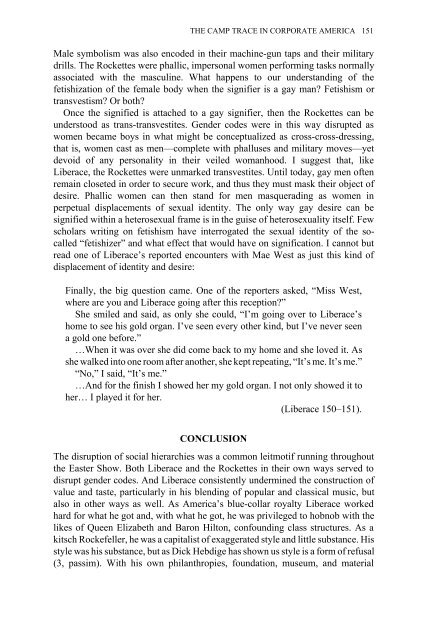Edited by Moe Meyer - Get a Free Blog
Edited by Moe Meyer - Get a Free Blog
Edited by Moe Meyer - Get a Free Blog
Create successful ePaper yourself
Turn your PDF publications into a flip-book with our unique Google optimized e-Paper software.
THE CAMP TRACE IN CORPORATE AMERICA 151<br />
Male symbolism was also encoded in their machine-gun taps and their military<br />
drills. The Rockettes were phallic, impersonal women performing tasks normally<br />
associated with the masculine. What happens to our understanding of the<br />
fetishization of the female body when the signifier is a gay man? Fetishism or<br />
transvestism? Or both?<br />
Once the signified is attached to a gay signifier, then the Rockettes can be<br />
understood as trans-transvestites. Gender codes were in this way disrupted as<br />
women became boys in what might be conceptualized as cross-cross-dressing,<br />
that is, women cast as men—complete with phalluses and military moves—yet<br />
devoid of any personality in their veiled womanhood. I suggest that, like<br />
Liberace, the Rockettes were unmarked transvestites. Until today, gay men often<br />
remain closeted in order to secure work, and thus they must mask their object of<br />
desire. Phallic women can then stand for men masquerading as women in<br />
perpetual displacements of sexual identity. The only way gay desire can be<br />
signified within a heterosexual frame is in the guise of heterosexuality itself. Few<br />
scholars writing on fetishism have interrogated the sexual identity of the socalled<br />
“fetishizer” and what effect that would have on signification. I cannot but<br />
read one of Liberace’s reported encounters with Mae West as just this kind of<br />
displacement of identity and desire:<br />
Finally, the big question came. One of the reporters asked, “Miss West,<br />
where are you and Liberace going after this reception?”<br />
She smiled and said, as only she could, “I’m going over to Liberace’s<br />
home to see his gold organ. I’ve seen every other kind, but I’ve never seen<br />
a gold one before.”<br />
…When it was over she did come back to my home and she loved it. As<br />
she walked into one room after another, she kept repeating, “It’s me. It’s me.”<br />
“No,” I said, “It’s me.”<br />
…And for the finish I showed her my gold organ. I not only showed it to<br />
her… I played it for her.<br />
(Liberace 150–151).<br />
CONCLUSION<br />
The disruption of social hierarchies was a common leitmotif running throughout<br />
the Easter Show. Both Liberace and the Rockettes in their own ways served to<br />
disrupt gender codes. And Liberace consistently undermined the construction of<br />
value and taste, particularly in his blending of popular and classical music, but<br />
also in other ways as well. As America’s blue-collar royalty Liberace worked<br />
hard for what he got and, with what he got, he was privileged to hobnob with the<br />
likes of Queen Elizabeth and Baron Hilton, confounding class structures. As a<br />
kitsch Rockefeller, he was a capitalist of exaggerated style and little substance. His<br />
style was his substance, but as Dick Hebdige has shown us style is a form of refusal<br />
(3, passim). With his own philanthropies, foundation, museum, and material


